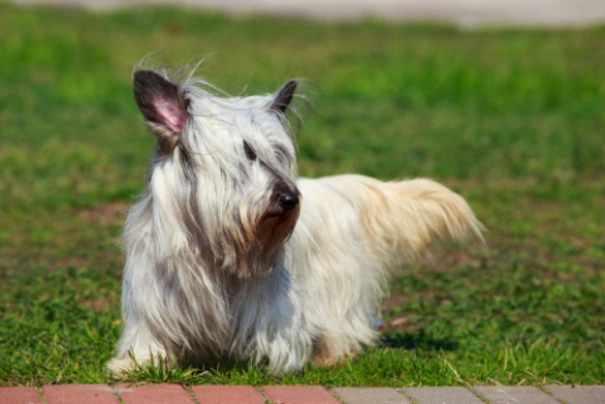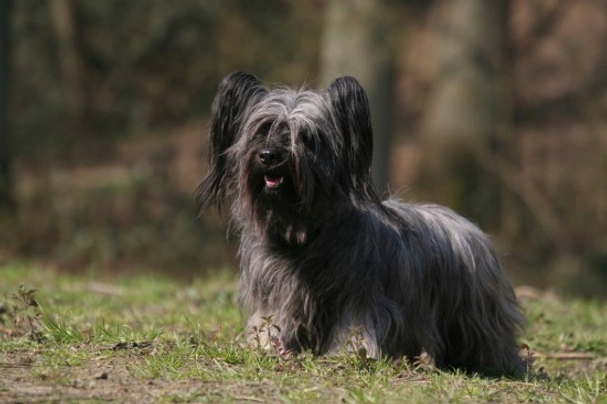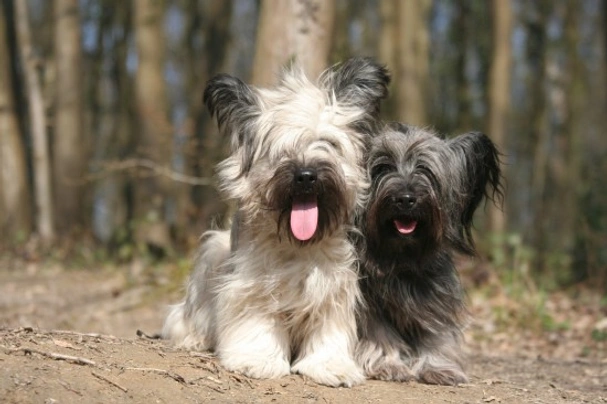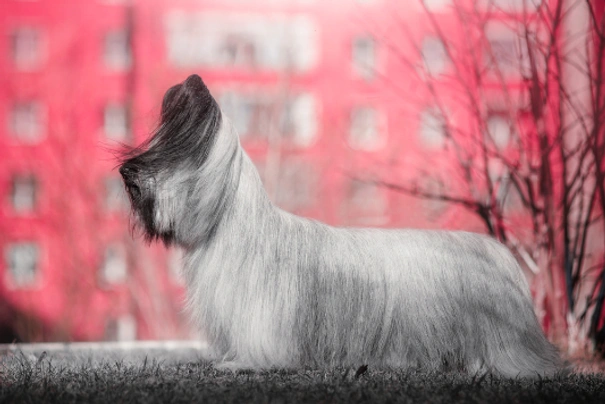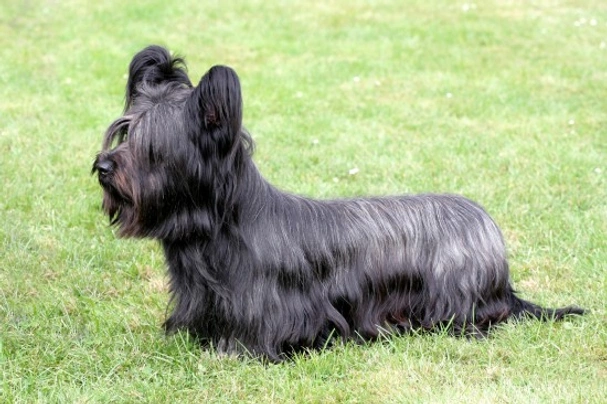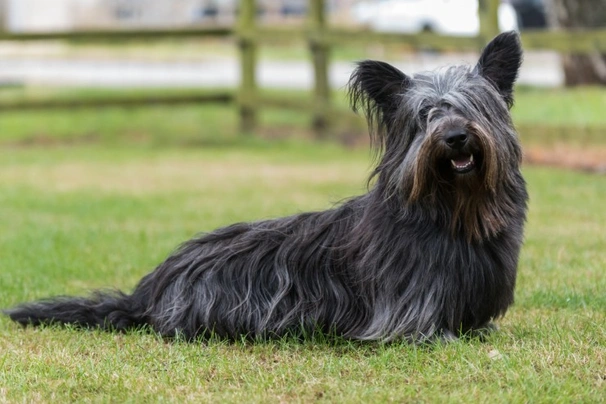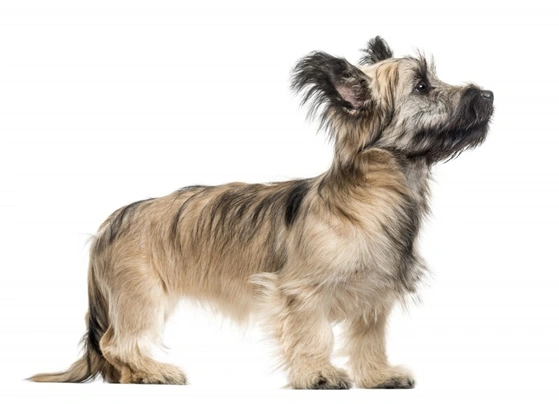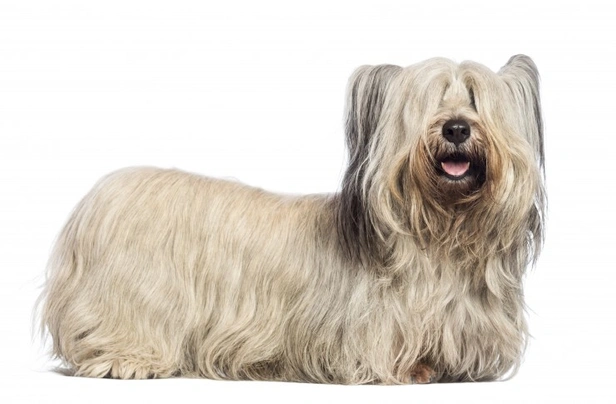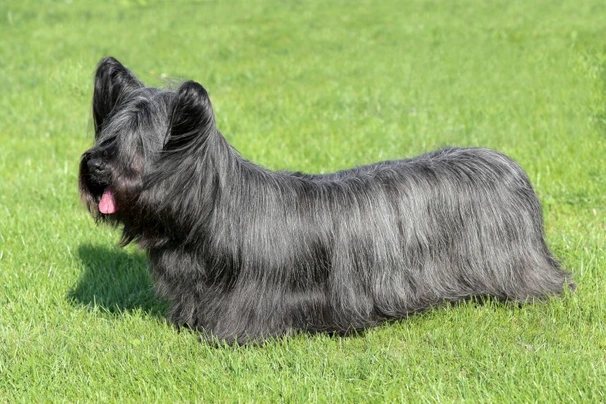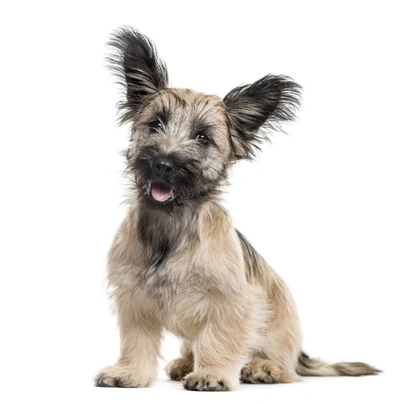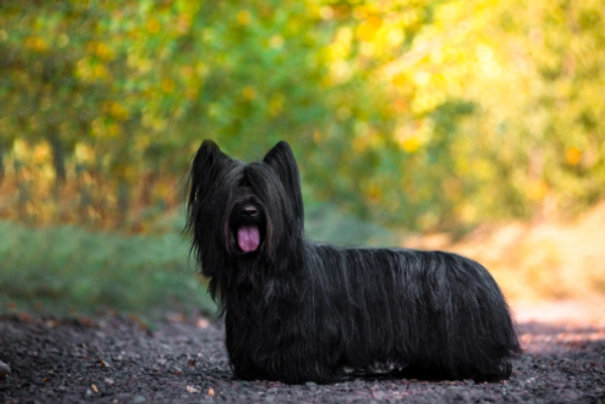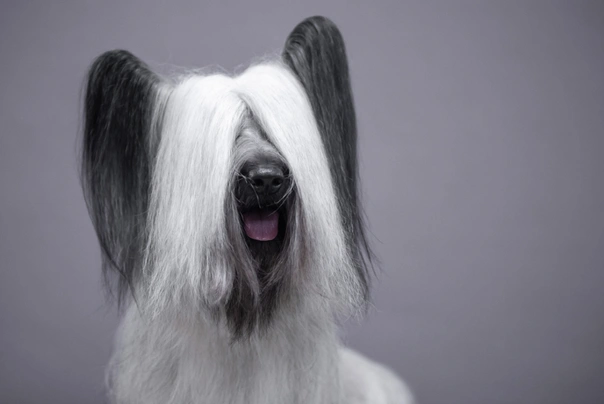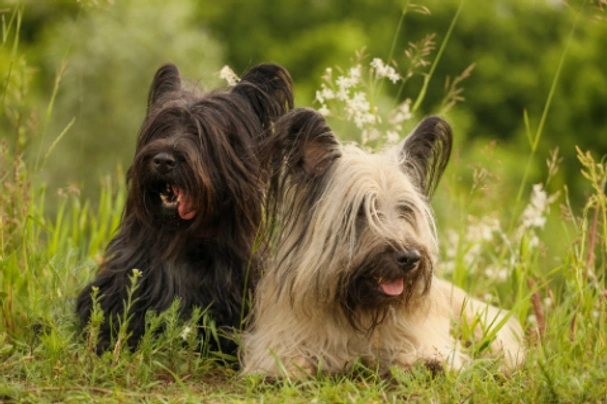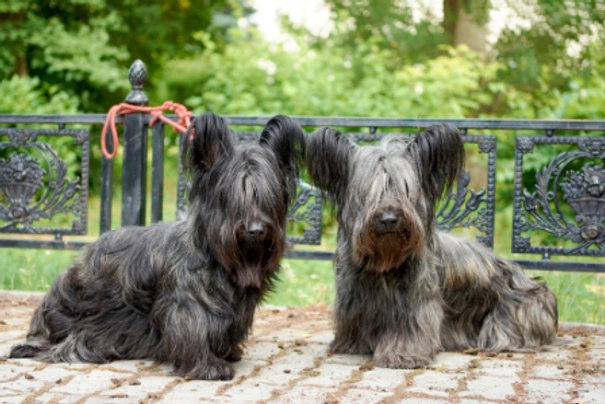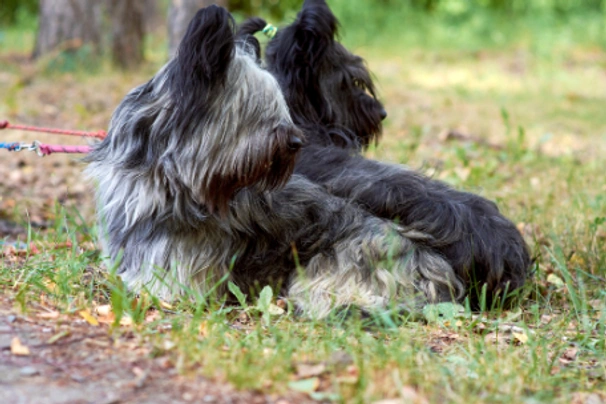Skye Terrier
Pros
Cons
Introduction of the Skye Terrier
The Skye Terrier was immortalised when a stature was erected of Greyfriars Bobby in Edinburgh. This little dog mourned his owners’ passing for 14 years by lying at his graveside. They are small dogs with short legs being longer in the body than they are tall. Sadly breed numbers have fallen over recent times which means they have been placed on The Kennel Club's list of vulnerable native breeds. As such anyone wishing to share their homes with a Skye Terrier would need to register their interest with breeders for the pleasure of doing so because few well-bred puppies are registered with The Kennel Club every year.
With this said Skye Terriers make wonderful family pets and companions being especially good around children and although they are wary at first around strangers as soon as they get to know someone they are always pleased to see them. They do have a high prey drive because they are terriers although when well socialised they generally get on with other dogs and family pets which are just some of the reasons the Skye Terrier has always been highly prized both as a working dog companion and family pet.
History of the Skye Terrier
Named after the Isle of Skye off the north west coast of Scotland the Skye Terrier is one of the oldest native breeds that boasts having Scottish origins. It is thought the breed can trace its ancestry back to the 14th Century. Throughout the centuries people needed terriers to control vermin and to chase down game. It is thought that many local Scottish terriers are descendants of dogs that survived a shipwreck during the time of the Spanish Armada in 1588 which are thought to have been Maltese. These dogs mated with local terriers and the result were dogs with long silky coats. It is known that Lady MacDonald of Armadale Castle owned “terrier” type dogs.
However although the story of shipwrecked dogs being crossed with local terriers is a nice one and that many Spanish ships were forced to sail north around the coast of Scotland to get away from the English ships many people believe it is just a legend and that the castle located at Armadale was not built until much later in time. With this said terrier type dogs existed on the Isle of Skye before 1588 which means they were around much earlier in time to when the Picts from Ireland invaded the Western Highlands before the Vikings arrived.
It is thought that many breeds were involved when it came to influencing Skye Terriers we see today and this includes dogs bought over by the Vikings which included the Drever and the Swedish Vallhund but the actual origins of the breed remain a bit of a mystery.
Skye Terriers were bred to hunt vermin and to go "to ground" in the pursuit of their quarry a job these little dogs proved to excel at. The dogs seen today have not changed that much from the dogs of days long past when the breed was known as the Clydesdale Terrier the Fancy Skye Terrier the Silky Skye Terrier the Glasgow Terrier and the Paisley Terrier. Queen Victoria was a big fan of the breed having bred them for many years in her kennel. This saw these charming dogs becoming a popular choice throughout her reign.
The breed was finally recognised by The Kennel Club in 1993 but their numbers have remained low which has seen the Skye Terrier being placed on The Kennel Club's list of vulnerable native breeds. As such anyone wishing to share their homes with a Skye Terrier would need to register their interest with breeders for the pleasure of doing so.
Interesting facts about the breed
- Is the Skye Terrier a vulnerable breed? Yes they have been put on the Kennel Club’s list of vulnerable native breeds and anyone wanting to share a home with a Skye would need to register their interest with breeders and go on a waiting list with puppies often commanding a lot of money
- Skye Terriers were bred to “go to ground” after their prey
- A beautiful statue was erected in the grounds of Armadale Castle in 2013 depicting 2 Skye Terriers one with drop ears and the other prick ears
- Skye Terriers are unique in their appearance and they have wonderful natures and personalities to match their impressive looks
- Unlike other terrier breeds a Skye Terrier’s tail was not customarily docked
Appearance of the Skye Terrier
Height at the withers: Males 23 - 25 cm Females 23 - 25 cm
Average weight: Males 8.5 - 10.5 kg Females 8.5 - 10.5 kg
The Skye Terrier maybe short in stature but they are dignified elegant dogs that have a lot of presence about them with the long flowing coats. They are twice as long as they are tall and when they move it seems as if they float. They have powerful long heads with a slight stop and strong muzzle. Their noses are black and their eyes are a dark brown being medium in size and closely set on a dog's face. Skye Terriers always have a keen alert and intelligent expression in their eyes.
They can have either pricked or dropped ears and when they are pricked they are nicely feathered and small. However when a dog has dropped ears they lie close to a dog's head and are larger. The Skye Terrier has a strong jaw with a perfect scissor bite where their upper teeth neatly overlap their lower ones. Their necks are slightly crested and long with dogs having broad shoulders deep chests and short well-muscled front legs.
A Skye Terrier's body is low and long with dogs having nice level backs and oval deep and long ribcages. Loins are short and hindquarters are full well developed and strong being nicely angulated. Back legs are well muscled straight and short and a Skye's front feet are bigger than their back ones but both have thick pads and strong nails. Their tails are long nicely feathered which dogs carry raised when excited or alert and lower when resting or relaxed.
When it comes to their coat the Skye Terrier boasts having a double coat that consists of a short soft woolly and close lying undercoat and a moderately long straight flat and harsh outer coat. The hair on a dog's head is shorter and much softer falling nicely over their forehead and eyes without interfering with their vision. The hair on the side of their faces and around their ears forms a fringe which adds to a Skye's unique look. The accepted breed colours for Kennel Club registration are as follows:
- Black
- Cream
- Cream Black Points
- Dark Grey
- Fawn
- Grey
- Light Grey
- Silver
- Silver Black Points
It is worth noting that the accepted breed colours for Kennel Club registration can differ from those set out in the breed standard which are as follows:
- Black
- Dark or light grey with black points
- Fawn with black points
- Cream with black points
It is worth noting that Skye Terriers can be any self-colour with shading of the same colour with undercoats being lighter providing that a dog’s nose and ears are black. Dogs can also have a small white spot on their chests which is permissible under their Kennel Club breed standard.
Gait/movement
When a Skye Terrier moves they so with their legs moving straight forward showing lots of drive from behind with their back legs also travelling straight forward. They give the appearance of moving with effortless ease without lifting their legs too high off the ground.
Faults
The Kennel Club frowns on any exaggerations or departures from the breed standard and would judge the faults on how much they affect a dog's overall health and wellbeing as well as their ability to perform.
Males should have both testicles fully descended into their scrotums and it is worth noting that a dog can be a little lighter or heavier as well as slightly taller or shorter than set out in the Kennel Club breed standard which is only given as a guideline.
Temperament of the Skye Terrier
Skye Terriers are renowned for being tenacious tough with a passion for digging and barking. Although very affectionate towards everyone in a household when kept as a family pet they form very strong bonds with one person and are very much a "one man one dog" characters. They can be a little "off" with younger children which in short means they are best suited to households where the children are older and who therefore know how to behave around dogs.
They are charismatic little dogs and they love nothing more than to be involved in everything that goes on around them. However they are naturally wary of people they have never met before but rarely would a Skye Terrier show any sort of aggression towards a stranger preferring to keep their distance and bark to let their owners know someone’s about.
It's really important for these dogs to be well socialised from a young age so they grow up to be confident outgoing mature dogs. Their socialisation has to include introducing them to lots of new situations noises people other animals and dogs once they have been fully vaccinated. It's also crucial for their training to start early too and it has to be consistent throughout a dog's life. A Skye is never happier than when they know their place in the pack and who they can look to for direction and guidance. If they don't know who the alpha dog is in a household they may quickly take on the role of dominant dog which can make them harder to live with and handle.
Skyes are typical of the terrier breed although they tend to be calmer than most. However they can be wilful and stubborn at times which is why they need to be handled with a firm yet gentle hand. They do not like to be left on their own for long periods of time and as such they are best suited to households where at least one person usually stays at home when everyone else is out of the house or a dog might start to suffer from separation anxiety.
Are they a good choice for first time owners?
Skye Terriers are a great choice for first time dog owners providing they have the time to dedicated to such an intelligent energetic terrier that is known to be so people-oriented loving nothing more than to please and to entertain their families. They are particularly good with young children and older people too although playtime can get a bit boisterous at times.
What about prey drive?
Being terriers Skye Terriers have a high prey drive and will happily chase anything that tries to run away from them or that they spot in the distance. As such care should always be taken as to where and when a dog can run off the lead more especially if there is wildlife of livestock close by.
What about playfulness? Fun-loving and comic
Skye Terriers are fun-loving and comical when they mood takes them and being so receptive to an owners’ moods they instinctively know when a person needs cheering up. They love playing games which includes things like tug of war and “fetch the toy”. With this said it’s important not to let a dog take over a game which could see them show a more dominant side to their natures bearing in mind that Skye Terriers can be strong-willed at times.
What about adaptability?
Sky Terriers are very adaptable and providing they are given enough mental stimulation and daily exercise they are just as happy living in town as they would be living in a house in the country.
What about separation anxiety?
Skye Terriers form strong ties with their families and dogs are never very happy when they find themselves left on their own for longer periods of time. They are better suited to people who either work from home or in households where one person stays at home when everyone else is out so they are never alone for any length of time which could see a dog suffering from separation anxiety. This can lead to them being destructive around the home which is a dog's way of relieving any stress they are feeling and a way to keep themselves entertained.
What about excessive barking?
Skye Terriers are known to like the sound of their own voices a little too much which is something that needs to be gently nipped in the bud when a dog is still young being careful not to frighten them which could end up making a dog withdrawn timid and shy.
Do Skye Terriers like water?
Most Skye Terriers love swimming and will take to the water whenever they can more especially when the weather is hot. However if anyone who owns a dog that does not like water should never force them to go in because it would just end up scaring them. With this said care should always be taken when walking a dog off the lead anywhere near more dangerous watercourses just in case a dog decides to leap in and then needs rescuing because they cannot get out of the water on their own.
Are Skye Terriers good watchdogs?
Because Skye Terriers are always on the alert they are known to be good watchdogs. They are naturally wary of strangers by nature means they are quick to bark when strangers are around. With this said rarely would a Skye show any sort of aggressive behaviour preferring to keep their distance and bark.
Intelligence / Trainability of the Skye Terrier
The Skye Terrier is a very smart dog and a quick learner. The downside to this is they are just as quick to pick up bad habits as they are the good. Their training has to begin early and it has to be consistent and always fair throughout a dog's life so they understand what owners expect of them. Skye Terriers are never happier than when they are given something to do which is why they are so amenable to learning new things.
The key to successfully training a Skye Terrier is to make their training as interesting as possible and to avoid too much repetition. It's also a good idea to keep training sessions short which helps dogs stay more focussed on what it’s being asked of them bearing in mind that the more intelligent a dog is the faster they get bored. It's also important to show dogs a lot of patience bearing in mind that Skye Terriers do boast a bit of a stubborn streak in them much like many other terrier breeds.
They do not answer well to harsh correction or any sort of heavy handed training methods but they do respond extremely well to positive reinforcement which always brings the best out of these intelligent and quick-witted dogs especially when there are high value rewards involved. However care has to be taken not to give too many food rewards because Skye Terriers are prone to gaining a lot of weight far too easily.
Like all puppies Skye Terriers are incredibly cute when young and it is all too easy to spoil them when they first arrive in new homes. As soon as a puppy is nicely settled owners must start out as they mean to go on by laying down ground rules and boundaries so that a puppy understands what is expected of them. It helps establish a pecking order and who the alpha dog is in the household. The first commands a puppy should be taught are as follows:
- Come
- Sit
- Stay
- Heel
- Quiet
- Leave it
- Down
- Bed
Children and other
Skye Terriers are known to be very good around children although they tend to be a little too high-spirited around smaller kids. As such they are best suited to households where the children are slightly older and who therefore know how to behave around dogs. They are not the best choice for families with very young children and any interaction between toddlers and a dog should always be well supervised by an adult to make sure playtime does not get too boisterous which could end up with someone being knocked over and hurt albeit by accident.
When dogs have been well socialised from a young enough age they generally get on well with other dogs they meet and if they have grown up with a family cat in a household they usually get on well together. However a Skye Terrier would think nothing of chasing off any other cats they encounter because they would see them as fair game. Care has to be taken when they are around any smaller animals and pets because they boast quite a high prey drive as such any contact is best avoided.
Health of the Skye Terrier
The average life expectancy of a Skye Terrier is between 12 and 15 years when properly cared for and fed an appropriate good quality diet to suit their ages.
The Skye Terrier is known to suffer from a few hereditary health issues which are worth knowing about if you are planning share your home with one of these energetic intelligent dogs. The conditions that seem to affect the breed the most include the following:
- Renal Dysplasia – dogs must undergo an ultrasound on both kidneys before being mated
- Skye Terrier Hepatitis
- Cancer
- Skye puppy limp - puppies between the age of 3 and 10 months are most affected
It is worth noting that the Kennel Club average breed COI for Skye Terrier currently stands at 17.1%.
What about vaccinations?
Skye Terrier puppies would have been given their initial vaccinations before being sold but it is up to their new owners to make sure they have their follow-up shots in a timely manner with the vaccination schedule for puppies being as follows:
- 10 -12 weeks old bearing in mind that a puppy would not have full protection straight away but would be fully protected 2 weeks after they have had their second vaccination
There has been a lot of discussion about the need for dogs to have boosters. As such it's best to talk to a vet before making a final decision on whether a dog should continue to have annual vaccinations which are known as boosters.
What about spaying and neutering?
A lot of vets these days recommend waiting until dogs are slightly older before spaying and neutering them which means they are more mature before undergoing the procedures. As such they advise neutering males and spaying females when they are between the ages of 6 to 9 months old and sometimes even when a dog is 12 months old.
Other vets recommend spaying and neutering dogs when they are 6 months old but never any earlier unless for medical reasons. With this said many breeds are different and it is always advisable to discuss things with a vet and then follow their advice on when a dog should be spayed or neutered.
What about obesity problems?
As with other breeds some Skye Terriers gain weight after they have been spayed or neutered and it's important to keep an eye on a dog's waistline just in case they do. If a dog starts to put on weight it's important to adjust their daily calorie intake and to up the amount of exercise they are given. Older dogs too are more prone to gaining weight and again it's essential they be fed and exercised accordingly because obesity can shorten a dog's life by several years. The reason being that it puts a lot of extra strain on a dog's internal organs including the heart which could prove fatal.
What about allergies?
Some Skye Terriers are prone to suffering from allergies and it's important for a dog to see a vet sooner rather than later if one flares up. Allergies can be notoriously hard to clear up and finding the triggers can be challenging. With this said a vet would be able to make a dog with an allergy more comfortable while they try to find out the triggers which could include the following:
- Certain dog foods that contain high levels of grains and other cereal-type fillers
- Airborne pollens
- Dust mites
- Environment
- Flea and tick bites
- Chemicals found in everyday household cleaning products
Participating in health schemes
All responsible Skye Terrier breeders would ensure that their stud dogs are tested for known hereditary and congenital health issues known to affect the breed by using the following schemes:
- All Skye Terriers must undergo an ultra-sound on both kidneys before being used in breeding programmes
What about breed specific breeding restrictions?
Apart from the standard breeding restrictions that are in place for all Kennel Club registered breeds there are no other breed specific breeding restrictions in place for the Skye Terrier but all breeders should follow Kennel Club breeding guidelines.
What about Assured Breeder Requirements?
Currently there are no Kennel Club breeder requirements in place for the Skye Terrier.
Caring for the Skye Terrier
As with any other breed Skye Terriers need to be groomed on a regular basis to make sure their coats and skin are kept in top condition. They also need to be given regular daily exercise to ensure they remain fit and healthy. On top of this dogs need to be fed good quality food that meets all their nutritional needs throughout their lives.
Caring for a Skye Terrier puppy
Skye Terrier puppies are boisterous and full of life which means it's essential for homes and gardens to be puppy-proofed well in advance of their arrival. A responsible breeder would have well socialised their puppies which always leads to more outgoing confident and friendly dogs right from the word go. With this said any puppy is going to feel vulnerable when they leave their mother and littermates which must be taken into account. The longer a puppy can remain with their mother the better although it should never be for too long either.
It's best to pick a puppy up when people are going to be around for the first week or so which is the time needed for a puppy to settle in. Puppy-proofing the home and garden means putting away any tools and other implements that a boisterous puppy might injure themselves on. Electric wires and cables must be put out of their reach because puppies love chewing on things. Toxic plants should be removed from flowerbeds and the home too.
Puppies need to sleep a lot to grow and develop as they should which means setting up a quiet area that's not too out of the way means they can retreat to it when they want to nap and it's important not to disturb them when they are sleeping. It's also a good idea to keep "playtime" nice and calm inside the house and to have a more active "playtime" outside in the garden which means puppies quickly learn to be less boisterous when they are inside.
The documentation a breeder provides for a puppy must have all the details of their worming date and the product used as well as the information relating to their microchip. It is essential for puppies to be wormed again keeping to a schedule which is as follows:
- Puppies should be wormed at 6 months old
- They need to be wormed again when they are 8 months old
- Puppies should be wormed when they are 10 months old
- They need to be wormed when they are 12 months old
Things you'll need for your puppy
There are certain items that new owners need to already have in the home prior to bringing a new puppy home. It's often a good idea to restrict how much space a puppy plays in more especially when you can't keep an eye on what they get up to bearing in mind that puppies are often quite boisterous which means investing in puppy gates or a large enough playpen that allows a puppy the room to express themselves while keeping them safe too. The items needed are therefore as follows:
- Good quality puppy or baby gates to fit on doors
- A good well-made playpen that's large enough for a puppy to play in so they can really express themselves as puppies like to do
- Lots of well-made toys which must include good quality chews suitable for puppies to gnaw on bearing in mind that a puppy will start teething anything from when they are 3 to 8 months old
- Good quality feed and water bowls which ideally should be ceramic rather than plastic or metal
- A grooming glove
- A slicker brush or soft bristle brush
- Dog specific toothpaste and a toothbrush
- Scissors with rounded ends
- Nail clippers
- Puppy shampoo and conditioner which must be specifically formulated for use on dogs
- A well-made dog collar or harness
- A couple of strong dog leads
- A well-made dog bed that's not too small or too big
- A well-made dog crate for use in the car and in the home that's large enough for a puppy to move around in
- Baby blankets to put in your puppy's crate and in their beds for when they want to nap or go to sleep at night
Keeping the noise down
All puppies are sensitive to noise including Skye Terrier puppies. It's important to keep the noise levels down when a new puppy arrives in the home. TVs and music should not be played too loud which could end up stressing a small puppy out making them withdrawn timid and shy.
Keeping vet appointments
As previously mentioned Skye Terrier puppies would have been given their first vaccinations by the breeders but they must have their follow up shots which is up to their new owners to organise. The vaccination schedule for puppies is as follows:
- 10 -12 weeks old bearing in mind that a puppy would not have full protection straight away but would only be fully protected 2 weeks after they have had their second vaccination
When it comes to boosters it's best to discuss these with a vet because there is a lot of debate about whether a dog really needs them after a certain time. However if a dog ever needed to go into kennels their vaccinations must fully up to date.
What about older Skye Terriers when they reach their senior years?
Older Skye Terriers need lots of special care because as they reach their golden years they are more at risk of developing certain health concerns. Physically a dog's muzzle may start to go grey but there will be other noticeable changes too which includes the following:
- Coats become coarser
- A loss of muscle tone
- They can either become overweight or underweight
- They have reduced strength and stamina
- Older dogs have difficulty regulating their body temperature
- They often develop arthritis
- Immune systems do not work as efficiently as they once did which means dogs are more susceptible to infections
- Older dogs change mentally too which means their response time tends to be slower as such they develop the following:
- They respond less to external stimuli due to impaired vision or hearing
- They tend to be a little pickier about their food
- They have a lower pain threshold
- Become intolerant of any change
- Often an older dog can feel disorientated
Living with a Skye Terrier in their golden years means taking on a few more responsibilities but these are easily managed and should include looking at their diet the amount of exercise they are given how often their dog beds need changing and keeping an eye on the condition of their teeth.
Older Skye Terriers need to be fed a good quality diet that meets their needs at this stage of their lives all the while keeping a close eye on a dog's weight. A rough feeding guide for older dogs is as follows bearing in mind they should be fed highly digestible food that does not contain any additives:
- Protein content should be anything from 14 – 21%
- Fat content should be less than 10%
- Fibre content should be less than 4%
- Calcium content should be 0.5 – 0.8%
- Phosphorous content should be 0.4 – 0.7%
- Sodium content should be 0.2 – 0.4%
Older Skye Terriers don't need the same amount of daily exercise as a younger dog but they still need the right amount of physical activity to maintain muscle tone and to prevent a dog from putting on too much weight. All dogs need access to fresh clean water and this is especially true of older dogs when they reach their golden years because they are more at risk of developing kidney disorders.
Grooming of the Skye Terrier
The Skye Terrier boasts having a long and silky coat as such they are high maintenance on the grooming front. Their coats need to be brushed every day to prevent any knots and tangles from forming. Particular attention has to be paid to their muzzles especially after they've eaten because food often gets stuck in the longer hair around their mouths which if left dirty could provide the perfect environment for a fungal infection to take hold.
They shed steadily throughout the year only more so during the Spring and then again in the Autumn when more frequent grooming is usually necessary to stay on top of things and to remove dead and shed hair from a dog's coat. It's also important to check a dog's ears on a regular basis and to clean them when necessary. If too much wax is allowed to build up it can lead to a painful infection which can be hard to clear up. In short prevention is often easier than cure with ear infections.
Exercise of the Skye Terrier
The Skye Terrier is an energetic intelligent dog and as such they need to be given the right amount of daily exercise and mental stimulation for them to be truly happy well-rounded dogs. They need a minimum of 1 hour a day with as much off the lead time as possible but only in a safe environment. If they are not given the right amount of mental stimulation and exercise every day a Skye Terrier would quickly get bored and could even begin to show some destructive behaviours around the home which is their way of relieving any stress they are feeling and not necessarily because they are being naughty.
A shorter walk in the morning would be fine but a longer more interesting one in the afternoon is a must with as much off the lead time as possible. These dogs also like to be able to roam around a back garden so they can really let off steam. However the fencing has to be extremely secure to keep these active high-energy dogs in because if they find a weakness in the fence they will soon escape and could get into all sorts of trouble.
With this said Skye Terrier puppies should not be over exercised because their joints and bones are still growing. This includes not letting a dog jump up and down from furniture or going up or down the stairs. Too much pressure placed on their joints and spines at an early age could result in a dog developing serious problems later in their lives.
Feeding of the Skye Terrier
If you get a Skye puppy from a breeder they would give you a feeding schedule and it's important to stick to the same routine feeding the same puppy food to avoid any tummy upsets. You can change a puppy's diet but this needs to be done very gradually always making sure they don't develop any digestive upsets and if they do it's best to put them back on their original diet and to discuss things with the vet before attempting to change it again.
Older dogs are not known to be fussy eaters but this does not mean they can be given a lower quality diet. It's best to feed a mature dog twice a day once in the morning and then again in the evening making sure it's good quality food that meets all their nutritional requirements. It's also important that dogs be given the right amount of exercise so they burn off any excess calories or they might gain too much weight which can lead to all sorts of health issues. Obesity can shorten a dog's life by several years so it's important to keep an eye on their waistline from the word go.
Feeding guide for a Skye Terrier puppy
Puppies need to be fed a highly nutritious good quality diet for them to develop and grow as they should. As a rough guide a Skye Terrier puppy can be fed the following amounts every day making sure their meals are evenly spread out throughout the day and it's best to feed them 3 or 4 times a day:
- 2 months old - 125g to 145g depending on puppy's build
- 3 months old - 138g to 170g depending on puppy's build
- 4 months old - 144g to 181g depending on puppy's build
- 5 months old - 145g to 184g depending on puppy's build
- 6 months old - 144g to 183g depending on puppy's build
- 7 months old - 132g to 166g depending on puppy's build
- 8 months old - 120g to 148g depending on puppy's build
- 9 months old - 119g to 132g depending on puppy's build
- 10 months old - 119g to 131g depending on puppy's build
Once a puppy is 11 months old they can be fed adult dog food.
Feeding guide for an adult Skye Terrier
Once fully mature an adult Skye Terrier should be fed a good quality diet to ensure their continued good health. As a rough guide an adult dog can be fed the following amounts every day:
- Dogs weighing 8.5 kg can be fed 115g to 134g depending on activity
- Dogs weighing 9.5 kg can be fed 126g to 146g depending on activity
- Dogs weighing 10.5 kg can be fed 136g to 156g depending on activity
Skye Terrier price
If you are looking to buy a Skye Terrier you would need to register your interest with breeders and agree to being put on a waiting list because very few puppies are bred and registered with The Kennel Club every year. You would need to pay anything upwards of £500 for a well-bred pedigree puppy.
The cost of insuring a male 3-year-old Skye Terrier in northern England would be £24.87 a month for basic cover but for a lifetime policy this would set you back £43.64 a month (quote as of May 2018). When insurance companies calculate a pet's premium they factor in several things which includes where you live in the UK a dog's age and whether they have been neutered or spayed among other things.
When it comes to food costs you need to buy the best quality food whether wet or dry making sure it suits the different stages of a dog’s life. This would set you back between £20 - £30 a month. On top of this you need to factor in veterinary costs if you want to share your home with a Skye Terrier and this includes their initial vaccinations their annual boosters the cost of neutering or spaying a dog when the time is right and their yearly health checks all of which quickly adds up to over £800 a year.
As a rough guide the average cost to keep and care for a Skye Terrier would be between £50 to £80 a month depending on the level of insurance cover you opt to buy for your dog but this does not include the initial cost of buying a healthy well-bred Kennel Club registered pedigree Skye Terrier puppy.
Buying advice
When visiting and buying any puppy or dog there are many important things to consider and questions to ask of the breeder/seller. You can read our generic puppy/dog advice here which includes making sure you see the puppy with its mother and to verify that the dog has been wormed and microchipped.
Because few Skye Terriers are bred and registered with the Kennel Club every year well-bred puppies can often command a lot of money. As such with Skye Terriers there is specific advice questions and protocols to follow when buying a puppy which are as follows:
- Beware of online scams and how to avoid them. You may see online and other adverts by scammers showing images of beautiful Skye Terrierpuppies for sale at very low prices. However the sellers ask buyers for money up front before agreeing to deliver a puppy to a new home. Potential buyers should never buy a puppy unseen and should never pay a deposit or any other money online to a seller. You should always visit the pet at the sellers home to confirm they are genuine and make a note of their address.
- As previously touched upon finding Skye Terrier puppies can prove challenging and waiting lists tend to be long. As such some amateur breeders/people breed from a dam far too often so they can make a quick profit without caring for the welfare of the puppies their dam or the breed in general. Under Kennel Club rules a dam can only produce 4 litters and she must be between a certain age to do so. Anyone wishing to buy a puppy should think very carefully about who they purchase their puppy from and should always ask to see the relevant paperwork pertaining to a puppy's lineage their vaccinations and their microchipping.
- Prospective owners would need to go on a waiting list for a Skye Terrier puppy because so few are bred and registered with the Kennel Club every year.

Gorgeous Skye terrier puppies
£1,700
Rare breed champion line Skyes ready 20 July
£1,500

